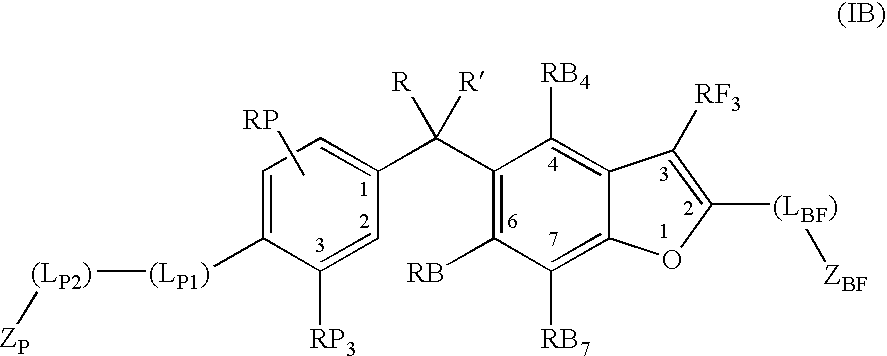Vitamin d receptor modulators
a technology of vitamin d receptor and transcription factor, which is applied in the field of ligand-dependent transcription factor, can solve the problems of insufficient separation to allow oral administration, hampered use of conventional vdr ligands, and inability to restore lost bone structure,
- Summary
- Abstract
- Description
- Claims
- Application Information
AI Technical Summary
Problems solved by technology
Method used
Image
Examples
example 2
Preparation of 2-{1-[4-(3,3-dimethyl-2-oxo-butoxy)-3-methyl-phenyl]-ethylpropyl}-benzofuran-5-carboxylic acid
[2135]
[2136] A solution of 2-{1-[4-(3,3-dimethyl-2-oxo-butoxy)-3-methyl-phenyl]-ethylpropyl}-benzofuran-5-carboxylic acid methyl ester (5.30 g, 11.8 μmmol) in methanol (30.0 mL) and THF (30.0 mL) is treated with NaOH (2.0 M, 60 mL). The resulting mixture is stirred at RT for 16 h. The mixture is concentrated and neutralized with HCl (5 N) till pH˜3, and extracted with EtOAc (2×100 mL). The organic layer is dried over Na2SO4, concentrated to afford the title compound (4.85 g, 94%).
[2137] H-NMR (ppm, CDCl3) δ: 8.34 (1H, d, J=1.8 Hz), 7.99 (1H, dd, J=1.8, 8.8 Hz), 7.38 (1H, d, J=8.8 Hz), 7.00 (1H, d, J=1.8 Hz), 6.95 (1H, dd, J=2.2, 8.4 Hz), 6.69 (1H, s), 6.54 (1H, d, J=8.4 Hz), 4.84 (2H, s), 2.26 (3H, s), 2.24-2.06 (4H, m), 1.26 (9H, s), 0.73 (6H, t, J=7.5 Hz).
[2138] MS (ES) m / e: 435.3 (M−1)
example 3
Preparation of 2-{1-ethyl-1-[4-(2-hydroxy-3,3-dimethyl-butoxy)-3-methyl-phenyl]-propyl}-benzofuran-5-carboxylic acid methyl ester
[2139]
[2140] A solution of 2-{1-[4-(3,3-dimethyl-2-oxo-butoxy)-3-methyl-phenyl]-ethylpropyl}-benzofuran-5-carboxylic acid methyl ester (1.70 g, 3.77 mmol) in THF (40 mL) at RT is treated with NaBH4 (286 mg, 7.54 mmol). The resulting mixture is stirred for 2 h and quenched with HCl (1 N, 8.0 mL), THF is removed in vacuum and the aqueous layer is extracted with EtOAc (2×40 mL). The combined organic layers are dried over Na2SO4, concentrated, purified on column chromatography (20% EtOAc / Hex) to afford the racemic intermediate alcohol (1.40 g, 82%). MS (ES) m / e: 453.2 (M+1)
example 4
Preparation of 2-{1-Ethyl-1-[4-(2-hydroxy-3,3-dimethyl-butoxy)-3-methyl-phenyl]-propyl}-benzofuran-5-carboxylic acid
[2141]
[2142] A solution of 2-{1-ethyl-1-[4-(2-hydroxy-3,3-dimethyl-butoxy)-3-methyl-phenyl]-propyl}-benzofuran-5-carboxylic acid methyl ester (555 mg, 1.226 mmol) in methanol (3.0 mL) and THF (3.0 mL) and is treated with NaOH (2.0 M, 6.0 mL). The resulting mixture is stirred at RT for 18 h. The mixture is concentrated and neutralized with HCl (1 N) till pH˜2, and extracted with EtOAc (3×10 mL). The organic layer is dried over Na2SO4, concentrated to afford the title compound (530 mg, 99%).
[2143] H-NMR (ppm, CDCl3) δ: 8.11 (1H, s), 7.99 (1H, dd, J=1.3, 8.4 Hz), 7.56 (1H, d, J=7.5 Hz), 7.01 (2H, m), 6.74 (1H, d, J=8.4 Hz), 6.68 (1H, s), 4.11 (1H, dd, J=2.6, 9.2 Hz), 3.88 (1H, t, J=9.2 Hz), 3.73 (1H, dd, J=2.6, 8.8 Hz), 2.20 (3H, s), 2.25-2.06 (4H, m), 1.02 (9H, s), 0.74 (6H, t, J=7.5 Hz).
[2144] MS (ES) m / e: 437.4 (M−1), 439.4 (M+1)
PUM
 Login to View More
Login to View More Abstract
Description
Claims
Application Information
 Login to View More
Login to View More - R&D
- Intellectual Property
- Life Sciences
- Materials
- Tech Scout
- Unparalleled Data Quality
- Higher Quality Content
- 60% Fewer Hallucinations
Browse by: Latest US Patents, China's latest patents, Technical Efficacy Thesaurus, Application Domain, Technology Topic, Popular Technical Reports.
© 2025 PatSnap. All rights reserved.Legal|Privacy policy|Modern Slavery Act Transparency Statement|Sitemap|About US| Contact US: help@patsnap.com



